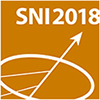Speaker
Description
$Cs_2CuCl_4$ and $Cs_2CuBr_4$ are anisotropic triangular lattice materials, where $Cu^{2+}$ ions with S=1/2 form frustrated 2D planes [1,2]. The mixed system $Cs_2CuCl_{4-x}Br_x$ is used to study the effect of controlled-quenched disorder in the spin superstructure lattice. Preferential occupation of Cl/Br leads to selective disorder in the lattice and some well-ordered structures. The neutron diffraction investigation of the magnetic phase diagram of $Cs_2CuCl_{4-x}Br_x$ provides detailed information about the influence of a specific Br concentration on the magnetic structure and help to clarify, how small modifications of the local $Cu^{2+}$ environment influence the exchange couplings and frustration in these compounds. Two different long-range ordered magnetic phases are found in this mixed system, and the first overview of the low-temperature magnetic phases of $Cs_2CuCl_{4-x}Br_x$ will be presented. The density functional theory (DFT) calculations show values of exchange coupling constants J, J´ for some ordered compositions of this mixed system. Furthermore, we start also studies in a magnetic field, because the quantum critical points are exciting, which may be also studied in the presence of disorder and potential spin-liquid phases in this mixed system.
[1] R. Coldea et al. J. Phys.: Condens Matter 1996, 8, 7473-7491
[2] T. Ono et al. J. Phys. Soc. Jpn. 2005, 74, 135

